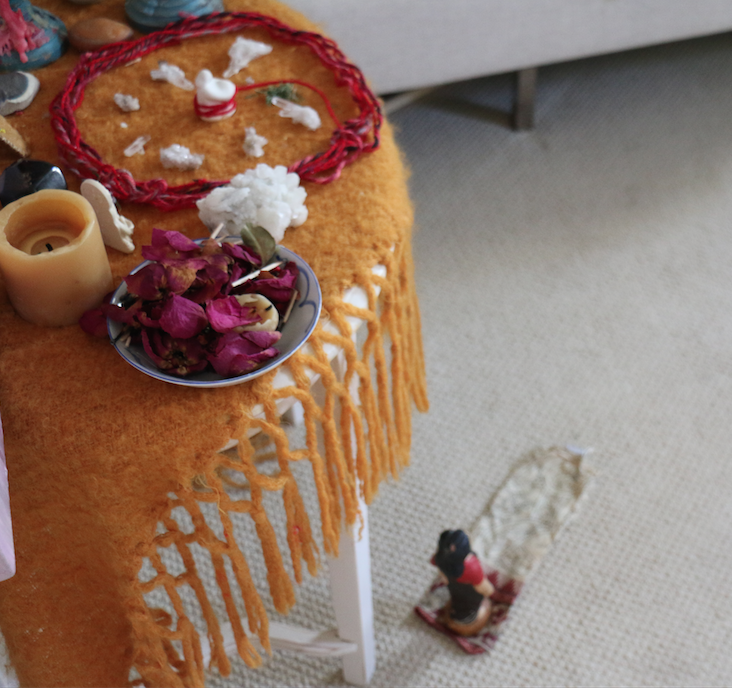
Stephen Jenkinson says, “There are three legs that make up the stand that suspends the cooking pot over the fire: One is the relationships within the village, one is the relationship with all the living things around, and one is the relationship with The Unseen and ancestors. If any one of the legs is missing, the village does not eat.”
Given that most people “eat” food but don’t know who made it, we could start wondering which one’s the forgotten leg?
Elder, Malidoma Some, of Burkina Faso, would say, “Ancestors are there hoping you’ll talk with them. They have a job, and it’s got to do with you.”
Shamanic Teacher, Sandra Ingerman, begins rituals by listing the beings, seen and unseen who will participate. She begins by thanking the elements (fire, water, air, and earth), followed by the spirit of the land where she is and the ancestors of that land, followed by the fairy folk and little folk, her own ancestors, and her guides and helping spirits. She sings to them before beginning any ceremonial undertaking, acknowledging them, and calling them in to help with the work. Once the ritual is complete, she thanks them again and lets them know that her work is done for now.
What’s going on?
Who is the ritual for?
The other day, my husband, Bruce, and I were talking about the difference between serving humanity and what modernity teaches about fulfilling “the self”. We came to the thought that although serving the self would be a natural and in some ways, a redeemed response, to the refusal of tyrannical traditional notions to acknowledge that each person has their own way in life, but that actually, it is not a solution at all, because everything else—all three of the legs are taken out. Individualism, as a response reminds me of a snake chasing its tail—nothing new happens, even though change is taking place. I think Stephen, Malidoma, and Sandra are saying that in a comprehensive, let’s call it Indigenous cosmology, something has to go—the individuated ego. It’s not only that we can’t do it on our own, but it’s a fantasy that we do it on our own.
And what if the Unseen, the spirit of things, the Anamistic, isn’t as invisible as we think? That rather it’s right here, on the other end of the conversation where the pause button has been pressed, ancient in its waiting-to-resume?
If we manage to crack open our imagination long enough to notice we’re constellated with a group of others, living and dead, plus an intelligence that lives generously all around our houses and cities in the form of plants and animals, then whoa—things can feel crazy really quickly. Crazy, because what gets called into action is “why do I insist on proceeding as as though all of this is on my shoulders alone?”
If you don’t know what a ritual is, we could just say it’s a formal set up of a prayer. It could be an ask for healing for oneself or others, a question that needs answering, a request for an impasse or challenge to shift direction. Undoubtedly, it starts with one or a group of human’s needs and wants. Inevitably though, if ritual is grounded in all three legs, all three are served.
I used to think this was all a bit abstract. It’s important to admit that I used to judge people who talked to plants. I thought they were avoiding the responsibilities of life, the smiles on their faces felt inauthentic, even sardonical, and I knew I would not ever be one of them.
Needless to say, when I had my first experience of a plant’s intelligence, it was conflicting. On one hand I felt enormous love coming from that plant (it happened to be a zucchini plant of all things) and I felt the old judgement of no one should see me doing this. Although it was years ago, and I spend a lot of time thanking the plant life around me and listening to them, I still have to get my courage up to put my hands on the big cedars where I walk my dog if other people are coming by.
What I know is that none of us know where to begin. We weren’t shown. Let that not be the last thought you have though. The conversation is silent because it was inherited that way. Your great-great grandparents lived their lives to learn as much as they could. Now they have something to share with you, as do the ones who came before them and before them. You may not like them, or what they did to your grandparents or your parents, or to others, and it’s okay to tell them that, but whether we like it or not, they are one of the legs that hold the cooking pot over the fire—they, the flora, fauna, and animals, and the other humans living at this time. Why not try introducing yourself again and see where the conversation flows. Maybe start with a “thanks”, and a remembering of what tiny sliver of information you may have about them, or the first question that jumps out of your imagination. Who knows, they might be the ones feeding you your lines, the the very genius behind your vocation, or the blessings of your children.

